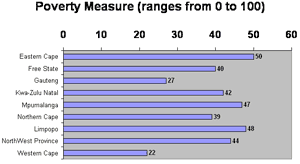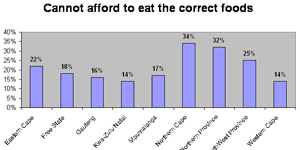Part of this study looks specifically at poverty levels via a special poverty index that is based on the provision of basic services (water, sanitation, power), access to telecommunications and transport, and adequacy of nutrition. This index runs from zero to one hundred.
Last year at the same time, the index stood at 43; in this year's study, it has dropped a notable four points, down to 39. Whilst there is still a long way to go, at least we are moving in the right direction overall.
Where is the problem the worst?
Three groups of people fare the worst:
People living in rural farm workers' quarters score an unacceptable high of 70.
Next are those in urban squatter shacks at 63.
Third are those living in rural villages at 60.The need for rural upliftment and for the improvement of the lives of people in urban squatter shacks is urgent. Quality of life improves immensely once people have a formal dwelling in which to live: people in formal houses in the former townships score a much better 30.
Where is the problem the least?
Because of the past, inevitably the question of population group emerges as a strong differentiator. Whilst blacks living in the townships and in informal areas score an overall average of 47 (down from 51 last year), those living in the former white suburbs score only eight, showing the extent of the disparity even now. Coloureds score 26 (down from 32) and Indians 12.
Regional differences
In terms of South Africa's provinces, the most poverty afflicted places are -
Eastern Cape at 50 (down from 53);
Limpopo at 48 (down from 50); and
Mpumalanga at 47 (down from 56).The least poverty afflicted provinces are Western Cape (22) and Gauteng (27).

Not enough to eat?
One in five adult South Africans say that they cannot afford to eat the correct foods. This rises to one on four of people over 50 years old and one in three of those at the bottom end of the income ladder and those unemployed.
In Soweto and in the Vaal Triangle, 25% of people cannot afford to eat the correct foods, compared to only 7% in Pretoria and Durban/Pietermaritzburg. However, once we moved outside the cities and towns, we found that the figure rose to 29% in rural villages and to an alarming 35% in rural farm worker's quarters. At a broader provincial level, the worst figures were recorded in the Northern Cape (34%) and Limpopo (32%) and the best in the Western Cape (14%) and KwaZulu-Natal (14%).

Poverty stress?
RS also calculates a stress/pressure index that lies on a scale of 0 to 100. This stress measure shows a strong correlation with poverty levels, and illustrates the fact that poverty leads to stress. Given that stress itself has a harmful effect on one's body (and many of these people do not have adequate nutrition already), as well as casting a shadow over many other aspects of people's lives, such as relationships, productivity and one's ability to achieve in life, it is clear that poverty alleviation is a critical priority for the country. It is so serious that everyone needs to be involved.